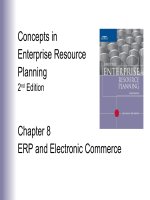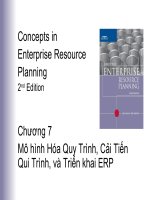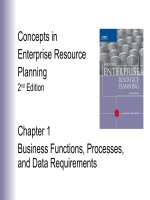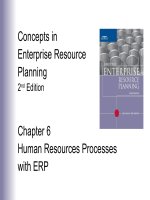Lecture concepts in enterprise resource planning (2nd edition) chapter 2 the development of enterprise resource planning systems
Bạn đang xem bản rút gọn của tài liệu. Xem và tải ngay bản đầy đủ của tài liệu tại đây (281.71 KB, 49 trang )
Concepts in
Enterprise Resource
Planning
2nd Edition
Chapter 2
The Development of Enterprise
Resource Planning Systems
Chapter Objectives
• Identify the factors that led to the development of
Enterprise Resource Planning (ERP) systems
• Describe the distinguishing modular
characteristics of ERP software
• Discuss the pros and cons of implementing an
ERP system
• Summarize ongoing developments in ERP
Concepts in Enterprise Resource Planning, Second Edition
2
Introduction
• Increasing the efficiency of information systems can
result in more efficient business processes, making a
company more competitive
• Integrating information systems across functional areas
is a relatively recent phenomenon
• Lack of integration can lead to costly inefficiencies
• Errors from keying in the same data more than once
• Lack of timely data due to periodic updating between
systems
• Problems with data being defined differently in
different systems
Concepts in Enterprise Resource Planning, Second Edition
3
Introduction
• ERP systems can integrate a company’s operations by
providing a company-wide computing environment that:
• Includes a single database shared by all functions
• Can deliver consistent data to all business functions
in real-time
• ERP systems can dramatically reduce costs and
increase operational efficiency
• With ERP, IBM Storage Systems division
• Reprices inventory in 5 minutes instead of 5 days
• Ships a replacement part in 3 days instead of 22
• Checks customer credit in 3 seconds instead of 20
minutes
Concepts in Enterprise Resource Planning, Second Edition
4
Evolution of Information Systems
• Using integrated software to manage all functional areas
of a business seems obvious today, but it was not
technically feasible until the 1990s
• Three factors contributed to the development of ERP
systems:
• Advancement of computer hardware and software
• Computing power, memory and communications
• Development of a vision of integrated information
systems
• Reengineering of companies to shift from a functional
focus to a managerial focus
Concepts in Enterprise Resource Planning, Second Edition
5
Computer Hardware and Software
• Computer hardware continues to get smaller, cheaper
and faster
• Gordon Moore, and Intel employee, noted that the
number of transistors on a computer chip, and thus its
power, doubled every 18 months
• This trend in computing power has continued to this
day
• The power of today’s computers has made the hardware
required for ERP systems affordable
• Moore’s observation is now known as Moore’s Law, and
is illustrated by Figure 2-1
Concepts in Enterprise Resource Planning, Second Edition
6
Figure 2-1
The actual increase in transistors on a chip approximates Moore’s Law
Courtesy of Intel Corporation
Concepts in Enterprise Resource Planning, Second Edition
7
Computer Hardware and Software
• Computer systems began as mainframe computers
• One large computer shared by many users who
communicated with the system by paper-punched
cards or paper tapes
• Terminals—primarily a monitor and keyboard with no
computing capability—were later used to
communicate with the mainframe computer
• The personal computer (PC) allowed individuals more
control over their computing
• Unique applications like word processing, spreadsheets
and presentation software were developed for the PC
• Sharing expensive peripheral equipment let to the
development of computer networks
Concepts in Enterprise Resource Planning, Second Edition
8
Computer Hardware and Software
• Sharing and managing important corporate data became
an even more important issue as PCs became more
common
• Client-server systems were developed to manage data
sharing. A central computer (server) managed the
storage and sharing of common data
• Client-server systems provided scalability. The capacity
of the network could be increased inexpensively by
adding a new server computer to the existing network
• Mainframe systems were generally not scalable.
Increasing capacity meant buying a new system
• Client-server systems are much more cost effective over
the long run
Concepts in Enterprise Resource Planning, Second Edition
9
Computer Hardware and Software
• A common database is a key component of an ERP
system
• Relational database systems were introduced in the
1970s
• These systems allowed for more efficient storage and
retrieval of data
• To support ERP systems, relational databases
needed to be able to find specific data quickly from a
large, complex database
• By the 1990s, the hardware, networks and database
software were in place to make large scale ERP systems
feasible
Concepts in Enterprise Resource Planning, Second Edition
10
Manufacturing Roots of ERP
• Materials Requirements Planning (MRP) software was
developed in the 1960s and ‘70s
• MRP software allowed firms to start with a sales forecast
and develop production and raw material plans
• For companies with many products, raw materials and
shared production resources, MRP was not possible
without a computer
• Electronic Data Interchange (EDI) allowed a company
to communicate its purchase requirements
electronically
• Sharing long-range production schedules between
manufacturers and suppliers was the beginning of
supply chain management (SCM)
Concepts in Enterprise Resource Planning, Second Edition
11
Functional Business Model
• Alfred P. Sloan developed the functional organizational
model in the 1930s as chairman of General Motors
• The functional model was very successful for decades,
but foreign competition in the 1980s highlighted
problems with the model:
• Flexibility and rapid decision-making were not
possible
• Organizations had become overstaffed and top-heavy
• Ability to respond to change was limited
Concepts in Enterprise Resource Planning, Second Edition
12
Title
Finance & Accounting
Information Flow
Logistics
Information Flow
Manufacturing
Information Flow
Sales
Information Flow
Marketing
Information Flow
Top Management
Material & Product Flow
Figure 2-2 Information and material flows in a functional business model
Concepts in Enterprise Resource Planning, Second Edition
13
Business Process Model
• In a process-oriented company, the flow of information
and management activity are “horizontal”—across
functions
• The “horizontal” flow promotes flexibility and rapid
decision-making
• Michael Hammer’s Reengineering the Corporation
encouraged managers to take a “horizontal” business
process view of their companies
Concepts in Enterprise Resource Planning, Second Edition
14
Top Management
Accounts
Payable
Finance &
Accounting
Accounts
Receivable
Procurement Manufacturing
Logistics
Information Flow
Supplies
Conversion
Customers
Suppliers
Marketing & Sales
Storage & Shipping
Material & Product Flow
Figure 2-3 Information and material flows in a process business model
Concepts in Enterprise Resource Planning, Second Edition
15
SAP
• Systemanalyse und Programmentwicklung (SAP) was
formed in Mannheim, Germany, in 1972 by five former
IBM systems analysts
• SAP’s goal was to develop a standard business software
product that could be configured to meet the needs of a
company
• SAP’s founders wanted
• Data to be available in real time
• Users to work on a computer screen, not with paper
• Lofty goals in 1972
Concepts in Enterprise Resource Planning, Second Edition
16
SAP
• SAP’s founders had to develop their first software
package at night on their first customer’s computer
• Computers were not commonly available in 1972
• The first software package was referred to by various
names, including R, RF and R/1
• Between 1978 and 1982, SAP developed a more
integrated software package, called R/2
• R/2 was still a mainframe computer package
• By 1988, SAP had developed R/2 into an international
software program and had sold 1,000 systems
Concepts in Enterprise Resource Planning, Second Edition
17
SAP R/3
• SAP R/3 was developed from 1988 to 1992
• R/3 is a client/server software package that could
operate on a number of computer systems, including
Windows NT and Unix
• Because it was a client/server system, it could easily
be scaled up as a company grew by adding additional
computers (servers) to the system
• R/3 was also an open architecture system
• Allows other software companies to develop
compatible products
• Makes integrating hardware like bar code
scanners, PDAs, cell phones, etc., easier
Concepts in Enterprise Resource Planning, Second Edition
18
Y2K
• Most business software programs written in the 1960s
and ‘70s saved storage space by using only 2 digits to
store the year
• For example, 10/29/75 rather than 10/29/1975
• With dates after 12/31/99, computer calculations were
likely to be in error
• 10/29/2001 might be interpreted as 10/29/1901 by a
program that only stored the date as 10/29/01
• Companies faced a choice as the new millennium
approached:
• Rewrite old software to store year data correctly
• Use problem as an opportunity to upgrade to ERP
Concepts in Enterprise Resource Planning, Second Edition
19
Y2K
• The Y2K problem created explosive sales growth for
Y2K-compliant ERP systems
• This lead to a significant shortage of experienced ERP
consultants, leading many companies to have problems
with their sometimes-rushed implementations
• The high demand for experienced ERP consultants prior
to Y2K was followed by an abrupt drop off by the middle
of 1999
• By middle 1999, companies had decided how they
were going to handle the Y2K problem, so new ERP
sales dropped significantly
Concepts in Enterprise Resource Planning, Second Edition
20
ERP Vendors
• Consolidation is currently taking place in the ERP
software business
• PeopleSoft purchased ERP vendor J.D. Edwards in
2003
• Oracle, after a long battle, acquired PeopleSoft in
2005
• SAP and Oracle are now the two largest ERP vendors
• Microsoft is challenging SAP and Oracle to sell ERP
systems to small- and medium-sized businesses
Concepts in Enterprise Resource Planning, Second Edition
21
SAP R/3 Enterprise
• SAP’s R/3 latest software version is called release 4.7 or
Enterprise
• R/3 Enterprise uses a central database to share data
between the primary functional areas of:
• Marketing and Sales
• Production and Materials Management
• Human Resources
• Accounting and Finance
Concepts in Enterprise Resource Planning, Second Edition
22
Data Flow between Functional Areas
Marketing
and Sales
Accounting
and Finance
Central
Data
Production and
Materials
Management
Human
Resources
Figure 2-4
Data flow within an integrated information system
Concepts in Enterprise Resource Planning, Second Edition
23
SAP R/3 Modules
• While SAP supports business processes, it is organized
around functional modules:
• The Sales and Distribution (SD) module records sales
orders and schedules deliveries
• Information like pricing, how and where to ship
products, how the customer is to be billed, etc. is
maintained in this module
• The Materials Management (MM) module manages
• The acquisition of raw materials from suppliers
(purchasing)
• Handling of raw materials inventory
• The Production Planning (PP) module is where
production is planned and scheduled, and actual
production activities are recorded.
Concepts in Enterprise Resource Planning, Second Edition
24
SAP R/3 Modules
• The Quality Management (QM) module helps to plan
and record quality-control activities, such as product
inspections and material certifications
• The Plant Maintenance (PM) module allows planning
for preventative maintenance of plant machinery and
managing maintenance resources
• The Asset Management (AM) module helps the
company to manage fixed-asset purchases (plant and
machinery) and the related depreciation.
• The Human Resources (HR) module facilitates
employee recruiting, hiring, training, payroll and
benefits.
• The Financial Accounting (FI) module records
transactions in the general ledger accounts. It is used
to generate financial statements for external reporting
purposes
Concepts in Enterprise Resource Planning, Second Edition
25









